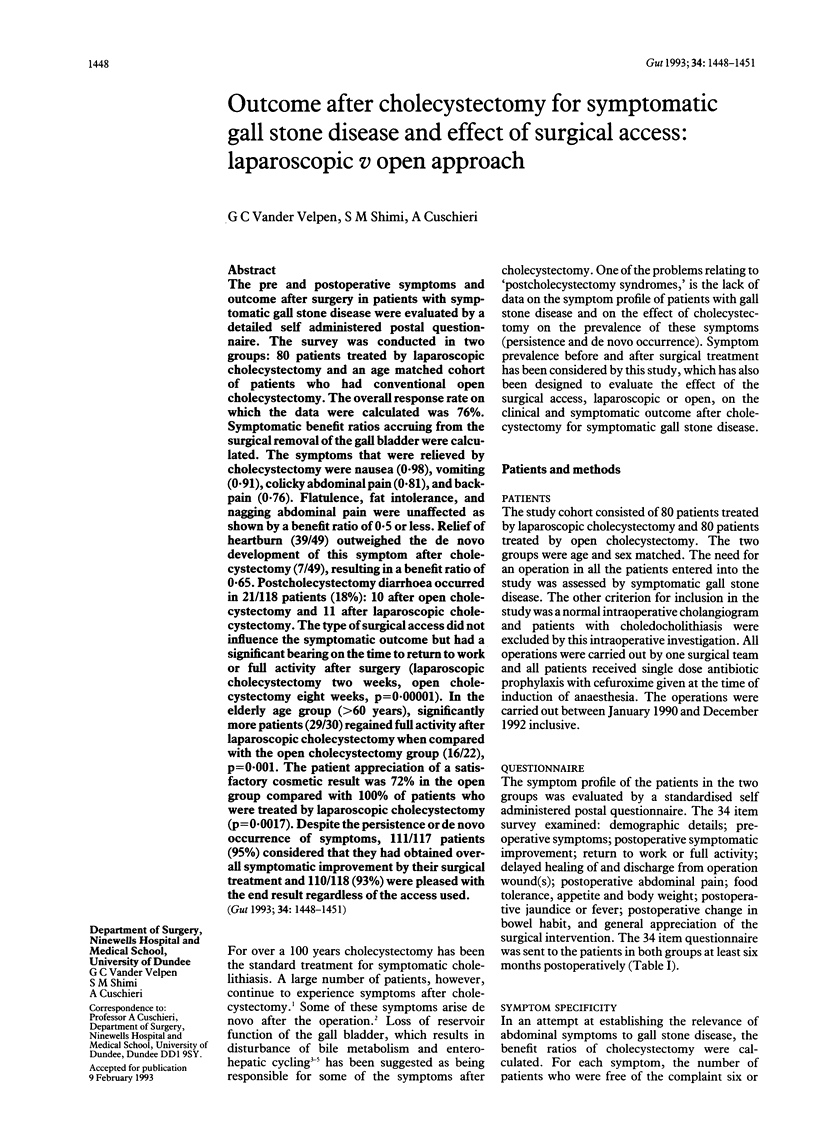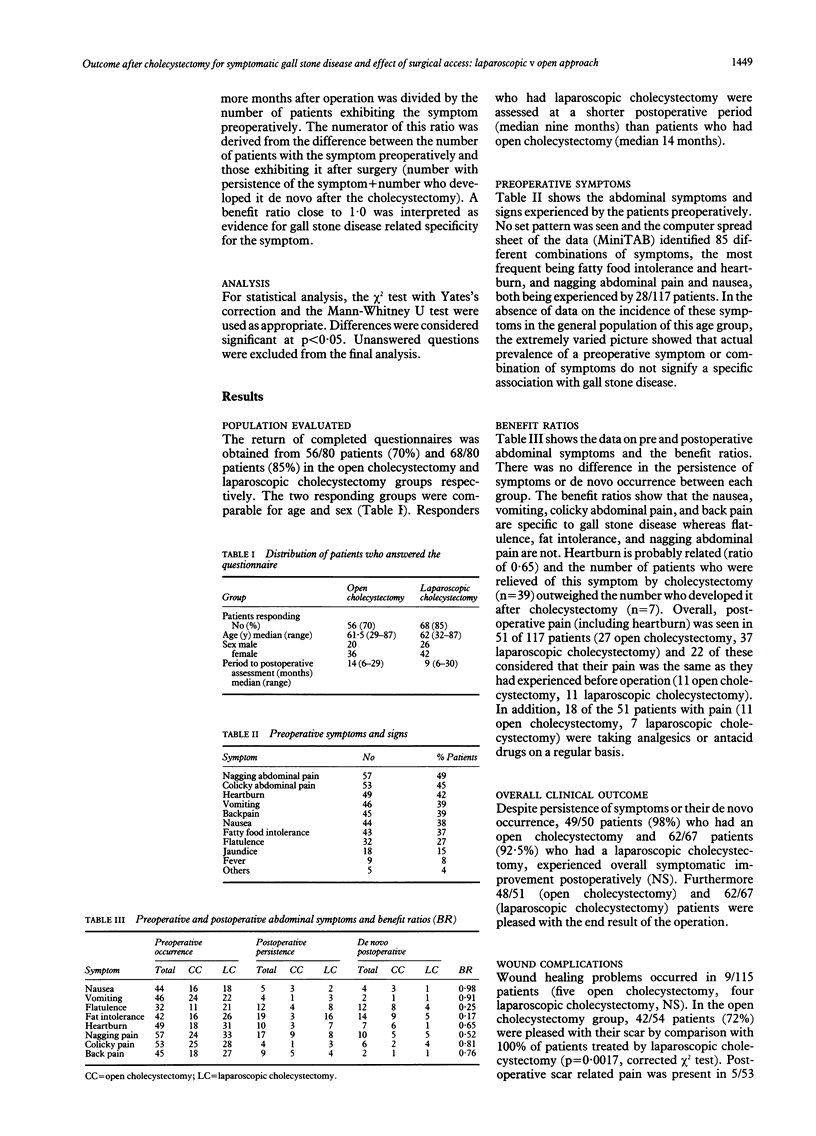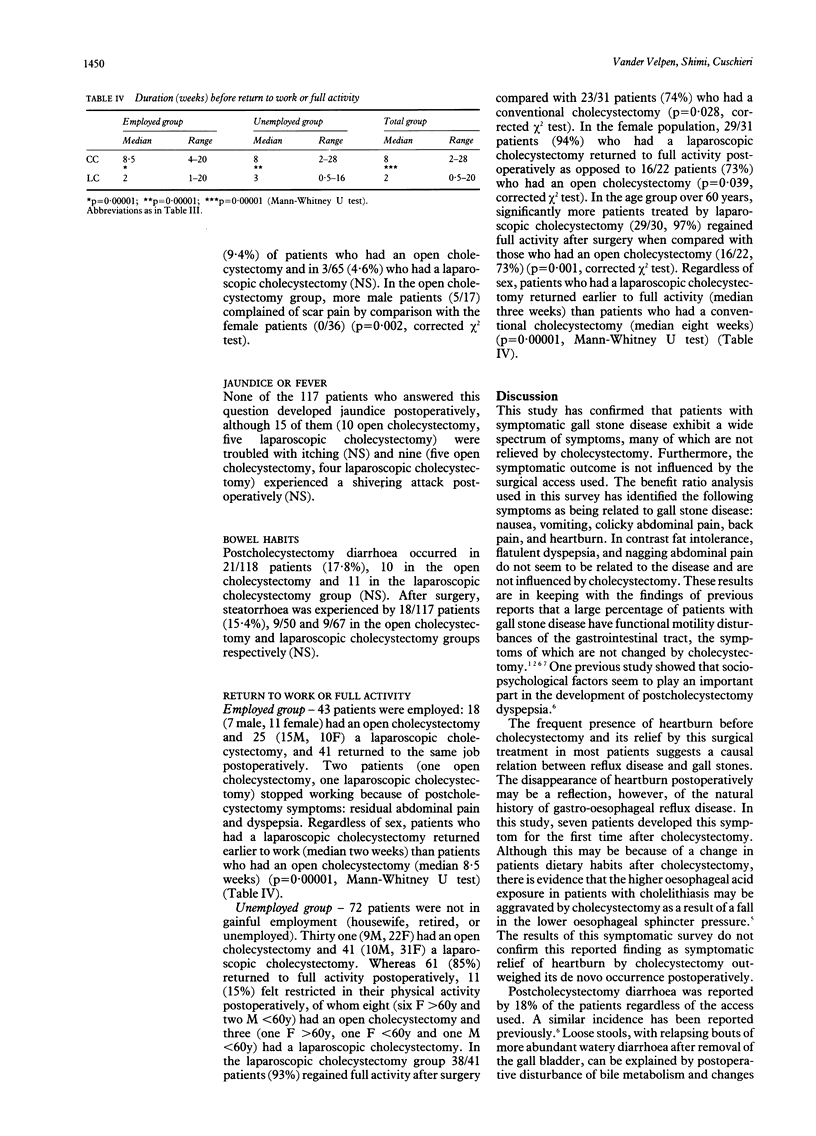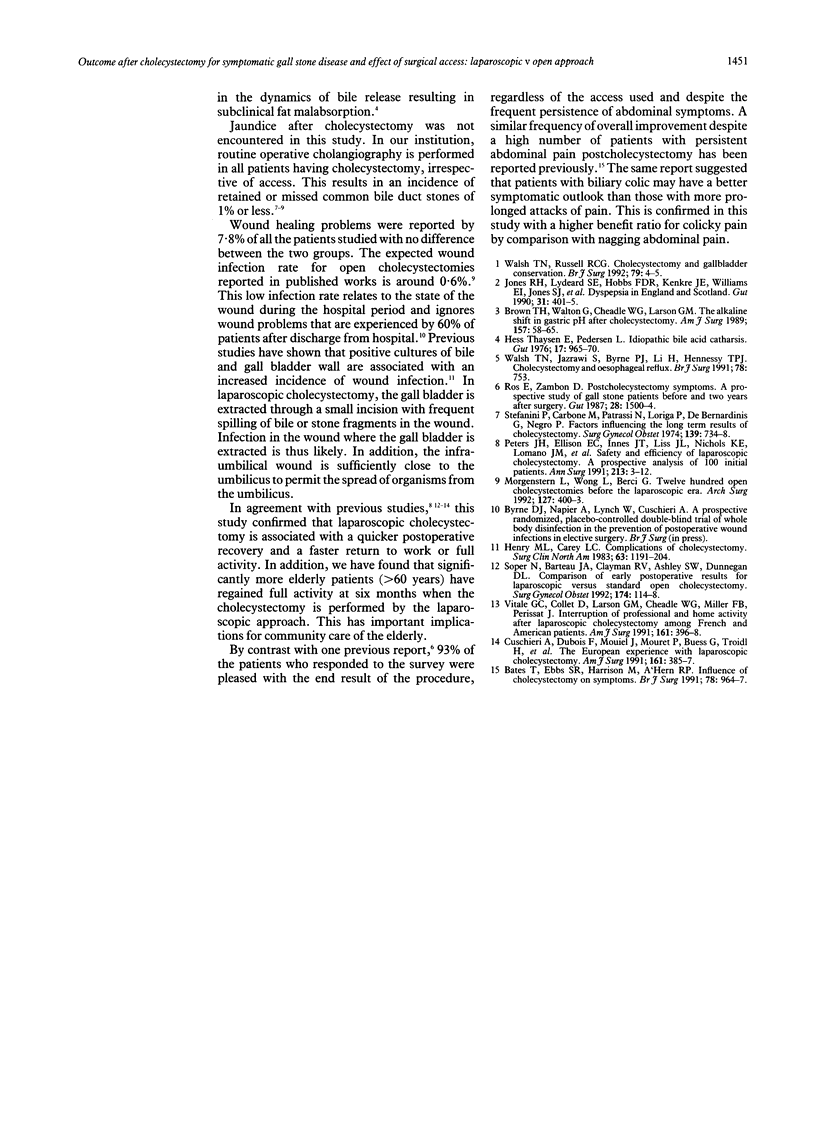Abstract
The pre and postoperative symptoms and outcome after surgery in patients with symptomatic gall stone disease were evaluated by a detailed self administered postal questionnaire. The survey was conducted in two groups: 80 patients treated by laparoscopic cholecystectomy and an age matched cohort of patients who had conventional open cholecystectomy. The overall response rate on which the data were calculated was 76%. Symptomatic benefit ratios accruing from the surgical removal of the gall bladder were calculated. The symptoms that were relieved by cholecystectomy were nausea (0.98), vomiting (0.91), colicky abdominal pain (0.81), and backpain (0.76). Flatulence, fat intolerance, and nagging abdominal pain were unaffected as shown by a benefit ratio of 0.5 or less. Relief of heartburn (39/49) outweighed the de novo development of this symptom after cholecystectomy (7/49), resulting in a benefit ratio of 0.65. Postcholecystectomy diarrhoea occurred in 21/118 patients (18%): 10 after open cholecystectomy and 11 after laparoscopic cholecystectomy. The type of surgical access did not influence the symptomatic outcome but had a significant bearing on the time to return to work or full activity after surgery (laparoscopic cholecystectomy two weeks, open cholecystectomy eight weeks, p = 0.00001). In the elderly age group (> 60 years), significantly more patients (29/30) regained full activity after laparoscopic cholecystectomy when compared with the open cholecystectomy group (16/22), p = 0.001. The patient appreciation of a satisfactory cosmetic result was 72% in the open group compared with 100% of patients who were treated by laparoscopic cholecystectomy (p = 0.0017). Despite the persistence or de novo occurrence of symptoms, 111/117 patients (95%) considered that they had obtained overall symptomatic improvement by their surgical treatment and 110/118 (93%) were pleased with the end result regardless of the access used.
Full text
PDF



Selected References
These references are in PubMed. This may not be the complete list of references from this article.
- Bates T., Ebbs S. R., Harrison M., A'Hern R. P. Influence of cholecystectomy on symptoms. Br J Surg. 1991 Aug;78(8):964–967. doi: 10.1002/bjs.1800780823. [DOI] [PubMed] [Google Scholar]
- Brown T. H., Walton G., Cheadle W. G., Larson G. M. The alkaline shift in gastric pH after cholecystectomy. Am J Surg. 1989 Jan;157(1):58–65. doi: 10.1016/0002-9610(89)90420-0. [DOI] [PubMed] [Google Scholar]
- Cuschieri A., Dubois F., Mouiel J., Mouret P., Becker H., Buess G., Trede M., Troidl H. The European experience with laparoscopic cholecystectomy. Am J Surg. 1991 Mar;161(3):385–387. doi: 10.1016/0002-9610(91)90603-b. [DOI] [PubMed] [Google Scholar]
- Henry M. L., Carey L. C. Complications of cholecystectomy. Surg Clin North Am. 1983 Dec;63(6):1191–1204. doi: 10.1016/s0039-6109(16)43182-8. [DOI] [PubMed] [Google Scholar]
- Jones R. H., Lydeard S. E., Hobbs F. D., Kenkre J. E., Williams E. I., Jones S. J., Repper J. A., Caldow J. L., Dunwoodie W. M., Bottomley J. M. Dyspepsia in England and Scotland. Gut. 1990 Apr;31(4):401–405. doi: 10.1136/gut.31.4.401. [DOI] [PMC free article] [PubMed] [Google Scholar]
- Morgenstern L., Wong L., Berci G. Twelve hundred open cholecystectomies before the laparoscopic era. A standard for comparison. Arch Surg. 1992 Apr;127(4):400–403. doi: 10.1001/archsurg.1992.01420040042006. [DOI] [PubMed] [Google Scholar]
- Peters J. H., Ellison E. C., Innes J. T., Liss J. L., Nichols K. E., Lomano J. M., Roby S. R., Front M. E., Carey L. C. Safety and efficacy of laparoscopic cholecystectomy. A prospective analysis of 100 initial patients. Ann Surg. 1991 Jan;213(1):3–12. doi: 10.1097/00000658-199101000-00002. [DOI] [PMC free article] [PubMed] [Google Scholar]
- Ros E., Zambon D. Postcholecystectomy symptoms. A prospective study of gall stone patients before and two years after surgery. Gut. 1987 Nov;28(11):1500–1504. doi: 10.1136/gut.28.11.1500. [DOI] [PMC free article] [PubMed] [Google Scholar]
- Soper N. J., Barteau J. A., Clayman R. V., Ashley S. W., Dunnegan D. L. Comparison of early postoperative results for laparoscopic versus standard open cholecystectomy. Surg Gynecol Obstet. 1992 Feb;174(2):114–118. [PubMed] [Google Scholar]
- Stefanini P., Carboni M., Patrassi N., Loriga P., De Bernardinis G., Negro P. Factors influencing the long term results of cholecystectomy. Surg Gynecol Obstet. 1974 Nov;139(5):734–738. [PubMed] [Google Scholar]
- Thaysen E. H., Pedersen L. Idiopathic bile acid catharsis. Gut. 1976 Dec;17(12):965–970. doi: 10.1136/gut.17.12.965. [DOI] [PMC free article] [PubMed] [Google Scholar]
- Vitale G. C., Collet D., Larson G. M., Cheadle W. G., Miller F. B., Perissat J. Interruption of professional and home activity after laparoscopic cholecystectomy among French and American patients. Am J Surg. 1991 Mar;161(3):396–398. doi: 10.1016/0002-9610(91)90606-e. [DOI] [PubMed] [Google Scholar]
- Walsh T. N., Russell R. C. Cholecystectomy and gallbladder conservation. Br J Surg. 1992 Jan;79(1):4–5. doi: 10.1002/bjs.1800790103. [DOI] [PubMed] [Google Scholar]


